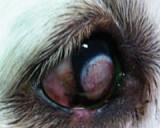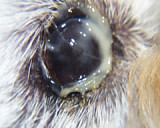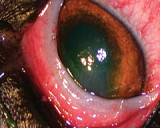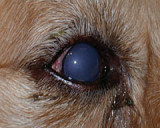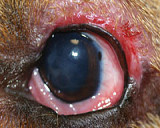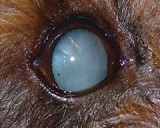A patient with corneal endothelial degeneration will present to you with a blue cloudy eye (corneal oedema). The endothelium is the deepest layer of the cornea. Unfortunately dogs and cats are only given one endothelium.
Once this layer is gone – that is it!! There is no second chance as the corneal endothelium is not regenerative. If the corneal oedema is severe then vision is impaired.
Before panicking there are some questions you should ask yourself.
What breed of dog is it?
Boston Terrier, Chihuahuas, English Springer Spaniels and Daschunds all get breed associated endothelial degeneration which is progressive.
Is the dog old?
Older dogs also get endothelial degeneration. It is important to stabilise these dogs before the cloudiness impacts on vision and quality of life.
Blue Cloudy Eye / Glaucoma Blue Cloudy Eye
How do you differentiate this blue cloudy eye from a glaucoma blue cloudy eye? Dogs with endothelial degeneration are often NOT painful like glaucoma dogs. These dogs usually have a normal pupillary light reflex and there is minimal perilimbal hyperaemia. 

Corneal Oedema & Glaucoma.
Management
These patients can be managed medically or surgically. Medical management consists of 5% hypertonic saline drops or ointment four times daily. This works by drawing the fluid away from the cornea on the epithelial side. Patients with advanced corneal degeneration benefit from surgery. There are two types of surgery. In advanced cases the excessive water in the cornea leads to water bubbles that burst and become painful superficial ulcers. These patients may benefit from a keratectomy or a multiple punctate thermokeratoplasty. These procedures are end stage and are not designed to improve vision.Treatment
There is another specialist surgical technique that can be used in either early or advanced cases. This is where an extremely thin section of conjunctiva is placed upon the cornea. The aim of this procedure is for the conjunctival blood vessels to draw fluid away from the cornea. When done early this may have a sparing effect on the remaining corneal endothelial cells thus slowing the progression of the corneal oedema. This is NOT a routine conjunctival graft. If the graft is too thick – the dog’s vision will not improve.
